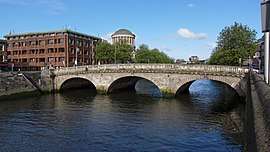Father Mathew Bridge
| Father Mathew Bridge Droichead an Athar Maitiú | |
|---|---|
 Father Mathew Bridge | |
| Coordinates | 53°20′44″N 6°16′33″W / 53.3455°N 6.2757°WCoordinates: 53°20′44″N 6°16′33″W / 53.3455°N 6.2757°W |
| Crosses | River Liffey |
| Locale | Dublin |
| Preceded by |
First built ~1014 - Dubhghall's Bridge Rebuilt 1385, 1394, 1428 - Known as The Bridge, Old Bridge, Dublin Bridge Rebuilt 1816 - Whitworth Bridge Renamed 1923 - Dublin Bridge Renamed 1938 - Father Mathew Br. |
| Characteristics | |
| Design | Elliptical arch stone bridge |
| Total length | ~45m |
| Width | ~15m |
| No. of spans | 3 |
| History | |
| Designer | George Knowles |
| Construction end | 1816 |
 Father Mathew Bridge Location in Central Dublin | |

Father Mathew Bridge (Irish: Droichead an Athar Maitiú)[1] is a road bridge spanning the River Liffey in Dublin, Ireland and joining Merchants Quay to Church Street and the north quays. It is approximately on the site of the original, and for many years only, Bridge of Dublin, dating back to the 11th century.
History
The site of the bridge is understood to be close to the ancient "Ford of the Hurdles",[2] which was the original crossing point on the Liffey and gives its name (in Irish) to the city of Dublin (Irish: Baile Átha Cliath, meaning "Town of the Hurdled Ford").
At the turn of the first millennium (c.1014), the first recorded Dublin Liffey bridge was built at this point. Possibly known as the Bridge of Dubhghall, this basic wooden structure was maintained and rebuilt over several centuries (from early Medieval to Viking to Norman times).
These rebuilds included a Norman bridge (sanctioned by King John) in the early 13th century.[3] This collapsed however in the late 14th century and in 1428, the Dominicans of Ostmantown Friary built the first masonry bridge in Dublin on the same spot.[2] Known as Dublin Bridge, Old Bridge, or simply The Bridge, this four arch structure had towers at either end, and shops, housing, an inn and a chapel were built on its supports. In 1312 Geoffrey de Morton, Lord Mayor of Dublin 1302-3 was reprimanded for building a house without permission on the bridge. On the other hand it was he who began building the towers, which were completed by his son-in-law John de Grauntsete, who later built St. Mary's Chapel on the Bridge.
For much of its 390-year life span, The Bridge carried all pedestrian, livestock and horse-drawn traffic across the river, and (as late as 1762) its tolls and chapel were still in use.
At the beginning of the 19th century, Dublin Bridge was replaced by a three-span, elliptical arch stone bridge. Designed by George Knowles (who also designed O'Donovan Rossa Bridge and Lucan Bridge), the bridge was opened in 1818[4] as Whitworth Bridge, for Charles, Earl of Whitworth, Lord Lieutenant of Ireland.
As with many other Dublin bridges (particularly those named for British peers), the bridge was renamed following independence by the Free State as Dublin Bridge in the 1920s.[5]
In line with another, later, Dublin tradition of naming bridges for temperance campaigners, the bridge was renamed again in 1938 for Father Theobald Mathew (the Apostle of Temperance) who was born at Thomastown near Golden, County Tipperary.[3]
References
- ↑ "Droichead an Athar Maitiú / Father Mathew Bridge". Logainm.ie - Database of Placenames' Commission. Retrieved 5 December 2016.
- 1 2 Project history of Dublin's River Liffey bridges (PDF). Bridge Engineering 156 Issue BE4 (Report). Phillips & Hamilton.
- 1 2 "Father Mathew Bridge entry". Architecture of Dublin City. Archiseek. 2010.
- ↑ Father Mathew Bridge at Structurae
- ↑ "Father Mathew Bridge - Timeline". Bridges of Dublin. Dublin City Council. Retrieved 5 December 2016.